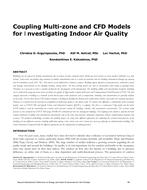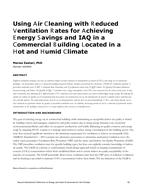-
-
Available Formats
- Options
- Availability
- Priced From ( in USD )
-
Available Formats
-
- Immediate download
- $16.00
- Add to Cart
Customers Who Bought This Also Bought
-

Learning from the Vernacular: The Impacts of Massive Per...
Priced From $16.00 -

Potential Alternative Lower Global Warming Refrigerants f...
Priced From $16.00 -

Coupling Multi-zone and CFD Models for Investigating Indo...
Priced From $16.00 -

A/C in High Ambient Temperatures: Comparisons Of Alternat...
Priced From $16.00
About This Item
Full Description
Different ventilation strategies can have an enormous impact on both exposures to contaminants of concern (COCs) and energy use in commercial buildings. An intervention study in a commercial building located in Miami, Florida assessed how the alternative ASHRAE ventilation methods 1) prescribed ventilation rates (VRP; Ventilation Rate Procedure) and 2) performance-based rates (IAQP; Indoor Air Quality Procedure) influenced measured energy and Indoor Air Quality (IAQ). Ventilation rates, energy consumption, and COCs were measured over the course of two years. Using lower ventilation rates following the IAQP procedure (75% reduction of hot and humid outside air) leads to double-digits energy savings. By reducing the outside air, indoor air quality can be maintained only if gas-phase air cleaning that acts on all contaminants of concern is applied (source reduction was not a feasible option). The study demonstrates that the use of self-regenerative sorbents that can treat formaldehyde, VOCs, and carbon dioxide can at least maintain an equivalent indoor air quality at prescribed ventilation rates. In addition, decreasing outside air led to a reduction of particulate matter concentrations as the building is located next to a major highway and a decrease in humidity levels.





